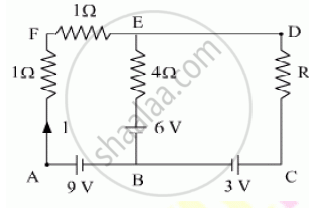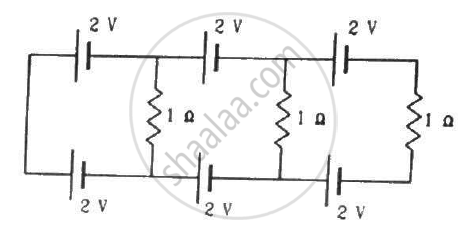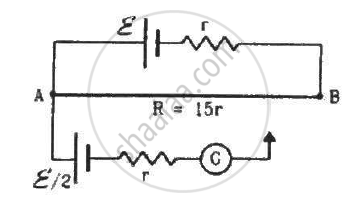Advertisements
Advertisements
प्रश्न
Derive the equation of the balanced state in a Wheatstone bridge using Kirchhoff’s laws.
उत्तर

In this case, Kirchhoff’s junction rule applied to junctions D and B (see the figure) immediately gives us the relations I1 = I3 and I2 = I4. Next, we apply Kirchhoff’s loop rule to closed loops ADBA and CBDC.
The first loop gives
–I1R1 + 0 + I2R1 = 0 ...(Ig = 0)
And the second loop gives, upon using I3 = I1, I4 = I2
I2R4 + 0 – I1R3 = 0
From the equation, we obtain,
`I_1/I_2 = R_2/R_1`
Whereas from the equation, we obtain,
`I_1/I_2 = R_4/R_3`
Hence, we obtain the condition
`R_2/R_1 = R_4/R_3`
This last equation relating the four resistors is called the balance condition for the galvanometer to give zero or null deflection.
The Wheatstone bridge and its balance condition provide a practical method for the determination of unknown resistance. Let us suppose we have an unknown resistance, which we insert in the fourth arm; R4 is thus not known. Keeping known resistances R1 and R2 in the first and second arm of the bridge, we go on varying R3 till the galvanometer shows a null deflection. The bridge then is balanced, and from the balance condition the value of the unknown resistance R4 is given by, R4 = `R_3 R_2/R_1`
APPEARS IN
संबंधित प्रश्न
State Kirchhoff's rules and explain on what basis they are justified.
State Kirchhoff's rules for an electric network. Using Kirchhoff's rules, obtain the balance condition in terms of the resistances of four arms of Wheatstone bridge.
Using Kirchhoff’s rules determine the value of unknown resistance R in the circuit so that no current flows through 4 Ω resistance. Also find the potential difference between A and D.

In the given circuit, assuming point A to be at zero potential, use Kirchhoff’s rules to determine the potential at point B.

Find the circuit in the three resistors shown in the figure.

An infinite ladder is constructed with 1 Ω and 2 Ω resistors, as shown in the figure. (a) Find the effective resistance between the points A and B. (b) Find the current that passes through the 2 Ω resistor nearest to the battery.

Consider the potentiometer circuit as arranged in the figure. The potentiometer wire is 600 cm long. (a) At what distance from the point A should the jockey touch the wire to get zero deflection in the galvanometer? (b) If the jockey touches the wire at a distance of 560 cm from A, what will be the current in the galvanometer?

State Kirchhoff ’s voltage rule.
Explain the determination of unknown resistance using meter bridge.
A copper wire of 10-6 m2 area of cross-section, carries a current of 2 A. If the number of electrons per cubic meter is 8 × 1028, calculate the current density and average drift velocity.
